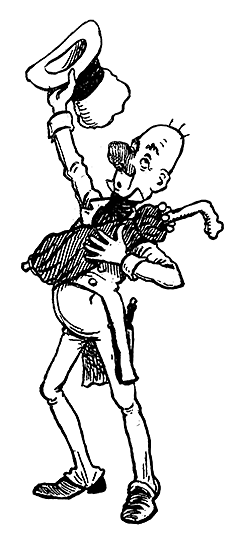Layabout, fraudster, tippler, womanizer, loudmouth, Ally Sloper was the first of a long line of resilient, optimistic con-men in British comics. His very name announces one of his character traits, derived as it is from his habit of sloping down the alley to avoid the debt collector, and, on occasion, his wife. Devised by Charles H. Ross for the comic magazine Judy in 1867, drawn from 1869 onwards by Marie Duval (real name Emily Louisa Tessier), Ally Sloper’s comic-strip adventures were gathered into a paperback usually known by its cover title Ally Sloper: A Moral Lesson (the title-page proper has Some Playful Episodes in the Career of Ally Sloper) in the year 1873. It was Duval who steered Sloper’s visual development in this first phase of his portrayal (Kunzle 1990: 316-22). Not only did she repeatedly and memorably draw those salient features of this character, bald head, bulbous nose, thin body, and spindly arms and legs, and also Sloper’s props, squashed stovepipe hat, battered umbrella, and that gin bottle protruding out of his back pocket. More importantly, she pushed forward the evolving comic strip, rendering it funnier and more allusive, with that close topicality that was to be an essential feature of the comics, while her rough, “naive” illustrative style well matched the rough story-lines of the strips. In 1884, Ally Sloper was recreated by cartoonist W. G. Baxter for the new comic paper Ally Sloper’s Half-Holiday, where for decades he was to appear on the cover page in a large, finely drawn, sophisticated cartoon. In the few years that he drew Sloper (1884 to 1886), while preserving his outward appearance and props, Baxter refashioned him as Ally Sloper F.O.M. (Friend of Man), a mock-gentrified surveyor of, and opinionated commentator on, social life and politics. His role was carried on in Baxter-style by his next illustrator, W. F. Thomas. Nationally revered by 1890, in the new decade the Sloper craze was to reach its peak, with huge sales of Ally Sloper’s Half-Holiday and related print items, plus an astounding variety of spin-off merchandising, and also many appearances in music halls, theatres and cinemas, all of which helped consolidate his status as a beloved British institution (Sabin 2003).
Meanwhile, further late-Victorian comic papers were emerging, and gradually, more and more comic strips began entering the recipe. James Henderson’s Funny Folks (founded 1874) was full of humorous material – cartoons, anecdotes, jokes, stories and the like – although few comic strips can be located in its pages. However, by characterizing itself in its first editorial as “a home comic”, it does have the distinction of employing the first printed use of the noun “comic” to designate a comic paper or magazine (Funny Folks, 12 December 1874). Henderson also brought out Scraps (1883) and Snap-Shots (1890), two papers that included a fair sprinkling of comic strips, many of which were pilfered from Western European and American sources. By this time, Alfred Harmsworth (later Lord Northcliffe) had been shrewdly analysing the market, and was ready to pounce, hastily assembling a paper he called Comic Cuts in 1890. Its huge success marked the beginning of the comics boom in Britain. The new comics cost a halfpenny each, and competition for these ha’pennies was fierce. Without revealing its exact weekly sales, the editor of Comic Cuts soon boasted that its circulation equalled the combined sale of all its competitors (Comic Cuts, 15 November 1890), a few months later assessing its average issue readership as “two or three million people” (Comic Cuts, 7 March 1891), and scornfully adding early the following year that most of the forty or fifty imitations had “died a lingering death” (Comic Cuts, 6 February 1892). To squash the remaining competition, Harmsworth speedily brought out a companion to his first comic, calling it Illustrated Chips (1890). Both of these comics initially pinched material from abroad, although they very soon relied almost exclusively on material provided by British artists. Short comic strips, along with single-picture cartoons, often appeared on the cover pages of these comics; full strips were rare. One of Harmsworth’s competitors, Trapps Holmes & Co., whose comic Funny Cuts had somehow evaded that “lingering death”, was the first British publisher to regularly place full-page strips on the front page of a comic, starting in October 1890 (Gifford 1987:19).

Ally Sloper, eternal optimist, serenades a lady – adapted from Ally Sloper's Half-Holiday, 1890